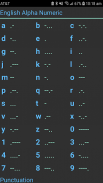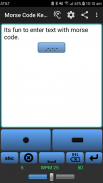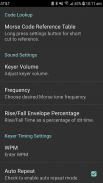





Morse Code Keyer

Descripción de Morse Code Keyer
Version 1.2.0 now has a much better keying feel due to lower sound latency.
The pro version now features a stand alone keyboard.
Morse Code Keyer allows text entry from Morse code input. It features a CW paddle type interface with a dit key and a dash key to enter the characters. This is good way to practice generating Morse code. This practice can solidify skills in learning and forming the Morse code characters. This skill can translate directly to sending CW on the ham radio bands if you have an amateur radio license. If you don't have a license, it can be fun to impress your friends with messages you composed with Morse code.
Features:
-Full Iambic keyer.
-Send entered text by SMS or email
-Iambic mode can be turned on and off.
-Adjustable auto word spacing.
-Easy adjustment of side tone frequency (200 – 1500Hz).
-Easy adjustment of WPM.
-Adjustment of sound envelope to affect quality of sound.
-Stand alone keyboard in pro version.
This is the free version and has the same functionality as the pro version, but contains ads and does not contain a stand alone keyer. Using this app is a good way to evaluate if this works well on your device.
The keyer is a full Iambic keyer with one caveat. If you push the dah key, then press the dit key, the characters will alternate like an Iambic keyer. The issue is if you lift your finger off of the dah key, the output will stop instead of continuing to repeat the dit character. This is due to the way Android multi-touch works. In the same scenario, lifting the dit finger will allow the dah characters to continue.
Morse Code Keyer features a settings screen where screen layout, keyer and sound settings are adjustable.
The layout options consist of turning on and off a small popup window. This window will show the dits and dahs as they are entered. The side of the screen the dit key is on can be adjusted (right or left). There is also an option that affects the visibility of the words per minute (WPM) slider.
For the keyer you can adjust whether or not the keys should repeat. For example, holding the dah key repeats the dah key at the current WPM setting. Iambic mode is also adjustable. With this on and when both keys are pressed, the dits and dahs will alternate. The auto spacing feature is also adjustable. This adds spaces automatically at word boundaries.
The sound setting that is adjustable is the rise and fall time envelope percentage. The percentage is of the total dit time. Longer values will make a softer sound, while shorter values give the sound more punch.
Thank you for your interest in Morse Code Keyer. If you any issues what so ever, please contact me rather than leave negative feedback. I will work with you to resolve the issues.
La versión 1.2.0 ahora tiene una sensación de incrustación mucho mejor debido a una menor latencia de sonido.
La versión pro ahora cuenta con un teclado independiente.
Morse Code Keyer permite la entrada de texto desde la entrada de código Morse. Cuenta con una interfaz de tipo paleta CW con una tecla dit y una tecla de guión para ingresar los caracteres. Esta es una buena forma de practicar la generación de código Morse. Esta práctica puede solidificar habilidades para aprender y formar los caracteres del código Morse. Esta habilidad puede traducirse directamente al envío de CW en las bandas de radioaficionados si tienes una licencia de radioaficionado. Si no tiene una licencia, puede ser divertido impresionar a sus amigos con mensajes que compuso con el código Morse.
caracteristicas:
-Completo Iambic keyer.
-Enviar texto ingresado por SMS o correo electrónico
-El modo ímbico se puede activar y desactivar.
- Espaciado automático de palabras ajustable.
-Fácil ajuste de la frecuencia de tono lateral (200 - 1500Hz).
-Fácil ajuste de WPM.
-Ajuste de la envolvente de sonido para afectar la calidad del sonido.
-Solo el teclado solo en la versión pro.
Esta es la versión gratuita y tiene la misma funcionalidad que la versión pro, pero contiene anuncios y no contiene un keyer independiente. Usar esta aplicación es una buena manera de evaluar si funciona bien en su dispositivo.
El keyer es un keyer ímbico completo con una advertencia. Si presiona la tecla dah, luego presione la tecla dit, los caracteres se alternarán como una llave de Iambic. El problema es que si levanta el dedo de la tecla dah, la salida se detendrá en lugar de continuar repitiendo el carácter dit. Esto se debe a la forma en que funciona Android multi-touch. En el mismo escenario, levantar el dedo dit permitirá que los caracteres dah continúen.
Morse Code Keyer presenta una pantalla de configuración donde la configuración de la pantalla, el keyer y el sonido son ajustables.
Las opciones de diseño consisten en activar y desactivar una pequeña ventana emergente. Esta ventana mostrará los dits y dahs a medida que se ingresan. El lado de la pantalla en el que está la tecla dit se puede ajustar (derecha o izquierda). También hay una opción que afecta la visibilidad del control deslizante de palabras por minuto (WPM).
Para el manipulador puede ajustar si las teclas deben repetirse o no. Por ejemplo, mantener presionada la tecla dah repite la tecla dah en la configuración actual de WPM. El modo yámbico también es ajustable. Con esto activado y cuando se presionan ambas teclas, los dits y dahs se alternarán. La función de espaciado automático también es ajustable. Esto agrega espacios automáticamente en los límites de palabras.
La configuración de sonido que es ajustable es el porcentaje de envolvente de tiempo de subida y bajada. El porcentaje es del tiempo total de dit. Los valores más largos producirán un sonido más suave, mientras que los valores más cortos le darán más fuerza al sonido.
Gracias por su interés en Morse Code Keyer. Si tienes algún problema, ponte en contacto conmigo en lugar de dejar un comentario negativo. Trabajaré con usted para resolver los problemas.
























